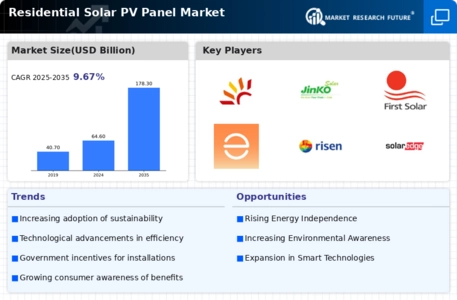Environmental Awareness
There is a growing consciousness regarding environmental issues, which is significantly influencing the Residential Solar PV Panel Market. As climate change becomes an increasingly pressing concern, consumers are more inclined to adopt sustainable practices. The transition to solar energy is perceived as a proactive measure to reduce carbon footprints and promote environmental stewardship. Recent surveys indicate that over 70 percent of homeowners express a desire to utilize renewable energy sources, with solar power being a primary choice. This heightened awareness is likely to drive demand for solar panels, as individuals seek to contribute positively to the environment while also benefiting from the financial incentives associated with solar energy. The Residential Solar PV Panel Market stands to gain from this shift in consumer attitudes, as more households prioritize eco-friendly solutions.
Increasing Energy Costs
The rising costs of traditional energy sources are driving consumers to seek alternative solutions, such as the Residential Solar PV Panel Market. As electricity prices continue to escalate, homeowners are increasingly motivated to invest in solar energy systems. In many regions, the cost of electricity has risen by over 30 percent in the last decade, prompting a shift towards renewable energy sources. This trend is likely to continue, as energy demand grows and fossil fuel prices fluctuate. Consequently, the Residential Solar PV Panel Market is positioned to benefit from this economic pressure, as solar panels offer a long-term solution to mitigate energy expenses. Homeowners recognize that investing in solar technology not only reduces their reliance on grid power but also provides potential savings on utility bills, making it an attractive option in the current economic landscape.
Technological Innovations
Advancements in solar technology are playing a crucial role in shaping the Residential Solar PV Panel Market. Innovations such as improved photovoltaic cell efficiency and energy storage solutions are making solar energy more accessible and effective for homeowners. For instance, the efficiency of solar panels has increased significantly, with some models achieving over 22 percent efficiency in converting sunlight to electricity. Additionally, the development of smart inverters and battery storage systems allows homeowners to maximize their energy use and store excess power for later use. These technological improvements not only enhance the performance of solar systems but also reduce installation costs, making solar energy a more viable option for a broader audience. As these innovations continue to emerge, the Residential Solar PV Panel Market is expected to expand, attracting more consumers to invest in solar solutions.
Government Policies and Incentives
Supportive government policies and incentives are pivotal in propelling the Residential Solar PV Panel Market forward. Many governments are implementing tax credits, rebates, and grants to encourage the adoption of solar energy. For example, tax incentives can cover a significant portion of installation costs, making solar panels more affordable for homeowners. In some regions, these incentives have led to a surge in solar installations, with reports indicating a 50 percent increase in residential solar projects in areas with robust support programs. Furthermore, renewable energy targets set by governments are likely to drive further investment in solar technologies. As policymakers continue to prioritize clean energy initiatives, the Residential Solar PV Panel Market is poised for growth, as more homeowners take advantage of these financial benefits.
Rising Demand for Energy Independence
The desire for energy independence is increasingly influencing consumer behavior in the Residential Solar PV Panel Market. Homeowners are seeking ways to reduce their dependence on traditional energy providers, particularly in light of fluctuating energy prices and supply uncertainties. By investing in solar energy systems, individuals can generate their own electricity, thereby enhancing their energy security. This trend is particularly pronounced in regions where energy supply is less stable or where utility rates are volatile. The Residential Solar PV Panel Market is likely to see a surge in interest as more consumers recognize the benefits of self-sufficiency in energy production. This shift towards energy independence not only empowers homeowners but also aligns with broader trends towards sustainability and resilience in energy consumption.


















Leave a Comment